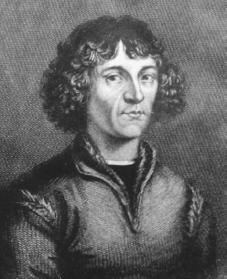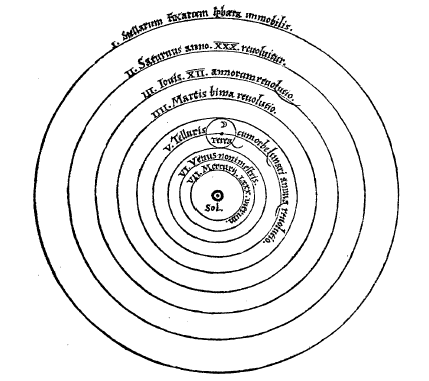Off-topic, Higgs: Fox News, BBC, and others are suddenly excited by the possibility suggested by the Higgs boson mass that our Universe is intrinsically unstable. See some 4-month or years old TRF blog entries.
 Mikołaj Kopernik was born on February 19th, 1473 – half a millennium and 9.5 months before your humble correspondent – into a rich family in Toruń (thorn) in Royal Prussia, a part of the Crown of the Kingdom of Poland.
Mikołaj Kopernik was born on February 19th, 1473 – half a millennium and 9.5 months before your humble correspondent – into a rich family in Toruń (thorn) in Royal Prussia, a part of the Crown of the Kingdom of Poland.At that time, the nationality of the people was more associated with the territory and not with ethnic groups: modern European 19th century nation states weren't born yet (American readers will forgive me but they still haven't invented the concept as of early 21st century).
However, Nicolaus spoke Polish, German, and Latin very well and equally well; he also spoke Greek and Italian. At some school, he was pretty much led to register himself as a German which doesn't mean much. His father was a successful copper trader at the Wall Street, selling the commodity to Danzig. His mother died when Nicolaus was a small boy but she was a member of a very rich dynasty.
Some people claim that the name "Koperník" is actually related to copper that his father traded. I find it unlikely. Such an influence of the job on the name seems too fast to me. It's more likely that it's related to the dill plant – koperek or kopernik in Polish, kopr in Czech, a Slavic word – that was abundant in Prussia.
He studied not only the mathematical-astronomical disciplines but also some theological ones (canon law) and some kind of humanities, too. I don't want to go into the boring list of institutions he was affiliated with. More interestingly, he organized defense against the attacks by the Teutonic Order (in Czech, we call it The Order of Germanic Knights); he worked as the canon in Frauenberg; drew some maps; and wrote macroeconomic analyses mostly focusing on inflation such as the Treatise on the Coin (he was a clear monetary hawk).
Some people could imagine that Copernicus was a life-long heretic of a sort but that's completely wrong. Theology was earning him a very convenient life. For example, in 1503, your humble correspondent's Kingdom of Bohemia gave him sinecure at the Collegiate Church of the Holy Cross in Wrocław, Silesia, Bohemia (yes, our territory was a bit bigger than today). Sinecure means that he didn't have to do anything. It was handy.
In 1514, he began to write blog entries about the heliocentric theory. And he wrote a book about it etc. Again, it would be a mistake to think that the Church was disgusted. For example, Pope Clement VII – and two cardinals – were told what the heliocentric theory had taught us by Johann Widmanstetter, the Holy Father's secretary. The Pope was so happy about the new insights that he gave the secretary a valuable gift.
The heliocentric system wasn't really new; some Greeks such as Aristarchus of Samos were discussing these models already 300 years before Christ. However, Copernicus was at least a major figure who revived the heliocentric idea in the Middle Ages and incorporated the state-of-the-art knowledge of astronomy into it so that it could have been considered a viable alternative to the prevailing Ptolemy's model.

This diagram of the Solar System looks really, really simple. It's remarkable why people weren't attracted by the simple model much more strongly than they actually were. This preference for "simpler models" is something we take for granted but it apparently wasn't always obvious. Copernicus was among the folks who helped us to prioritize the ideas in this way. We should be more precise when we say what is simple. The ultimate application of the model and calculations of observed phenomena may be rather complex; what's important is that the primary starting ideas such as the diagram above is simple.
Copernicus hasn't really faced any problems with the fundamentalist Christian ideology during his lifetime. His main problem came in 1538 when Johannes Dantiscus, a new bishop who had still been friend of Copernicus' at that time, accused Copernicus of coitus with Anna Schilling, a housekeeper (an act incompatible with his celibate). In 1538, Copernicus relinquished the Breslau sinecure (one of the jobs where he had no duties) and this fact is probably related to the accusation. Nevertheless, Copernicus never married and never had children.
The real controversy about the Copernican system only began to be built after Copernicus' death. Various Dominicans and Luther's collaborators and others were gradually finding inconvenient truths in Copernicus' writing and they were building fan clubs of haters who would ultimately transform Copernicus' theory into a magnificent heresy. Note that Giordano Bruno was burned at the stake in 1600, 57 years after Copernicus' death. (Bruno's valid claims went beyond Copernicus; he also recognized that the Sun was a star and he even claimed that there are "infinitely many" inhabited planets orbiting various other stars in the Universe.) The trial against Galileo took place in 1633.
Dozens of blog entries at this blog mention Copernicus. I am going to single out the myths about epicycles where I try to explain that the Copernican model, while having a more modern and simpler "core", didn't away with the need for epicycles. Epicycles were a clever phenomenological theory to improve the precision of the orbits – which are not exactly circular in the real world – some kind of higher harmonic corrections to the leading harmonic orbits in a Fourier expansion. Most contemporary people who feel very clever by slinging mud on epicycles understand astronomy much less than the 15th and 16th century astronomers.

There's really nothing wrong with the geocentric frame; it is just another coordinate system in which the motion of the celestial bodies (yellow Sun, blue Earth, red Mars) may be described. In general relativity, we're allowed to use both frames but it's still true that the metric tensor (gravitational) field in the heliocentric system is "simpler", more stationary, closer to the flat Minkowski space, and that's why the heliocentric frame was much straighter a path towards the Newtonian theory, a non-relativistic limit of GR.
Also, I have to mention that Copernicus is often cited as the "role model" for the proponents of the anthropic principle and the multiverse. They say that the world is always greater than previously thought and this process has been underway since Copernicus, we hear. It's the Copernican Revolution according to them. Well, I think they are rewriting the history a bit. Copernicus hasn't really enlarged the Universe and the revolution was about the change of the celestial body at the center of the Universe. (As I mentioned above, Giordano Bruno surely did propose to extend the world. Maybe the anthropic folks should talk about the Brunian Revolution.)
But OK, the role of the Earth was downgraded – and in the same way, the anthropic folks want to downgrade the whole observable Universe. The problem is that if the former step were legitimate, it doesn't follow that the latter step is legitimate. These are two different questions and attempts to identify them in between the lines is an ideology, not a proper logical reasoning. There's another key difference between the two situations: the worlds outside the Earth may be observed (so their existence is really indisputable today) while the worlds outside the observable Universe cannot be observed (which is a big reason why their existence is questionable). ;-)
0 comments:
Post a Comment